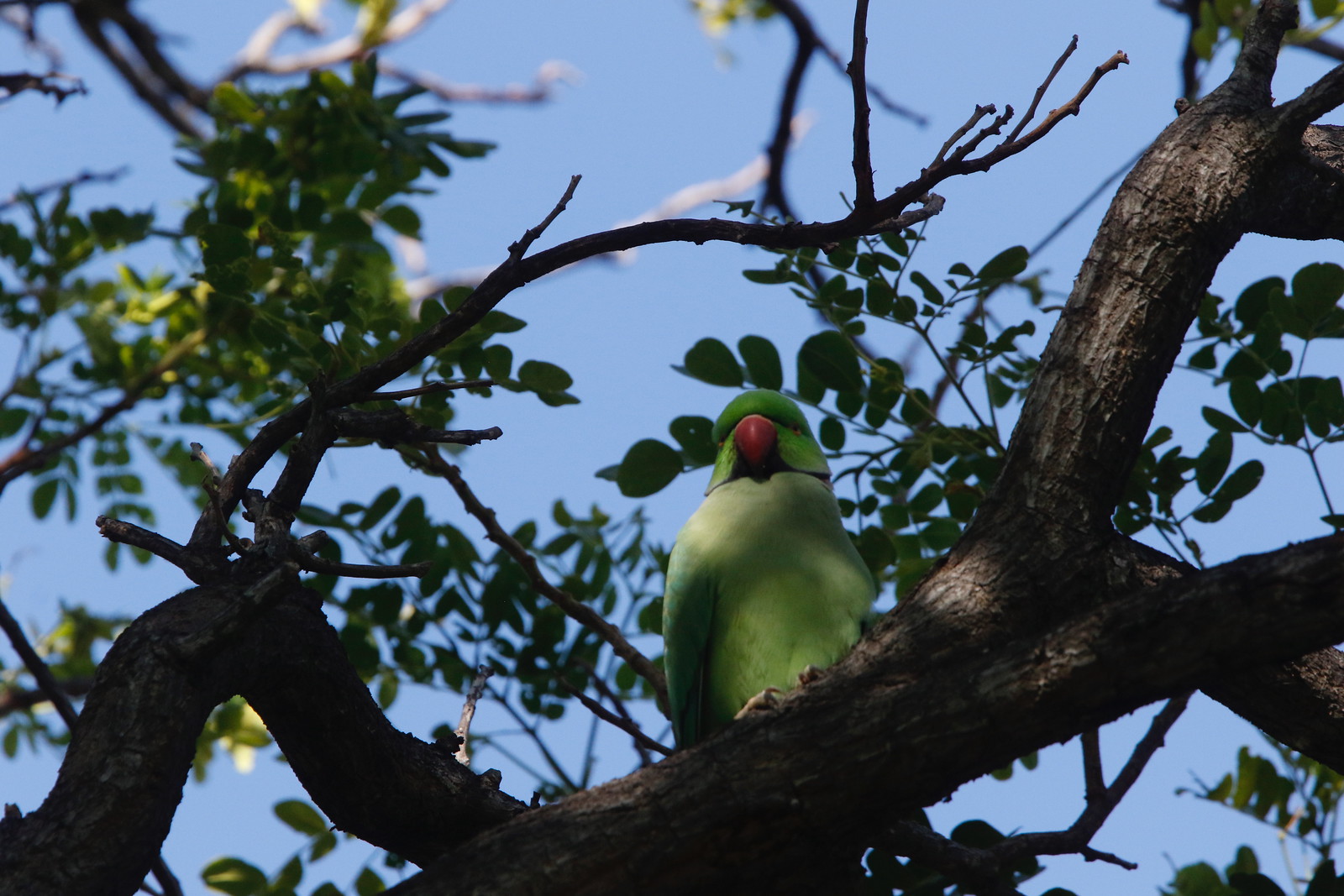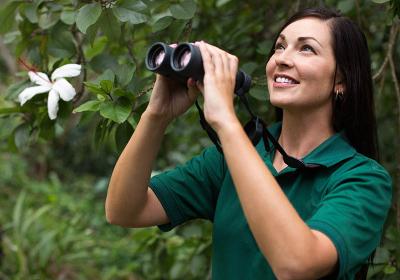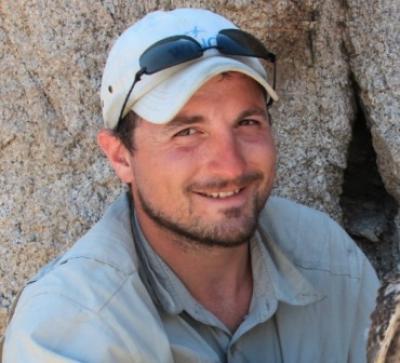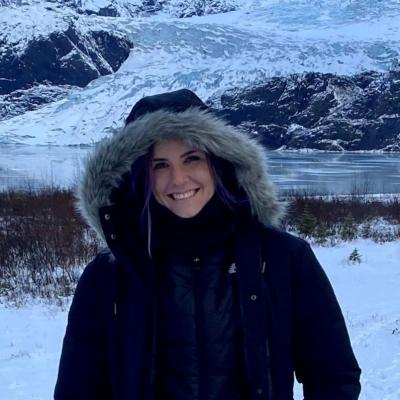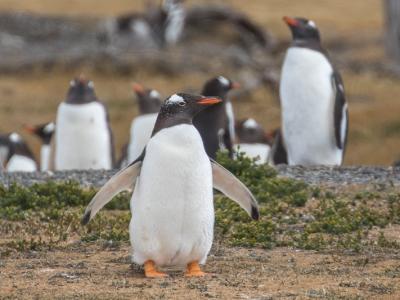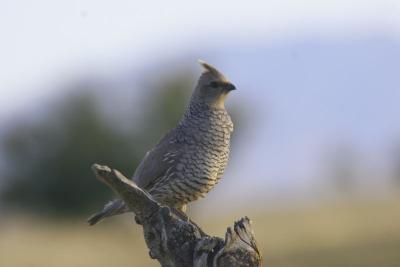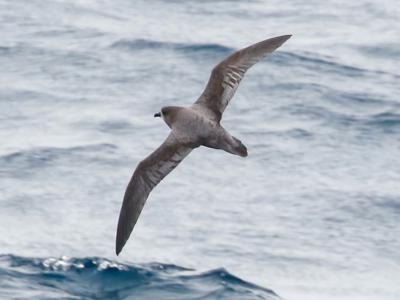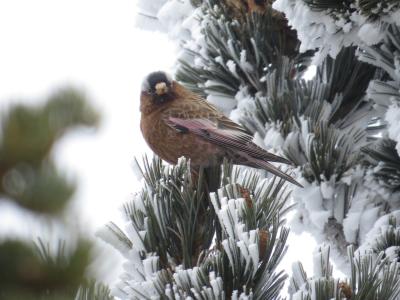Hawaii
Rainbow of Birds
-
Mar 2-10, 2025
Mandy Talpas and Jake Mohlmann
-
Mar 2026
Mandy Talpas
2026 Tour Price to be Determined
2026 Tour Price to be Determined
It might be the 50th state, but birding Hawai‘i feels like a world away. Without vagrancy, no remote islands would have land birds. Here, on one of the world’s most remote archipelagos, the chance arrival of far-flung waifs—a rosefinch and a monarch flycatcher from the East, and a solitaire and several waterbirds from North America—led to mind-blowing adaptive radiation that resulted in the evolution of a host of unique species. The ancestral finch, for example, gave rise to the Hawaiian Honeycreepers, which have developed such a huge range of shapes, sizes, and especially bills, from curlew-like curves for probing cavities to grosbeak-like seed-smashers, that some argue the honeycreepers even put “Darwin’s Finches” to shame. Unfortunately, the one variable that these species have in common is a tough time adapting to the arrival of humans. Since the first Polynesians arrived in the islands, hunting, habitat loss, introduced avian diseases, and introduced predators have rapidly lead to a marked decline in native forest birds. This tour will celebrate the species that persist despite the myriad threats. We hope not only to raise awareness and spur more support for their conservation, but also to marvel at the adaptations of some of the most unique species in the world. And let’s be brutally honest here—we may simply not have time to wait much longer to see some of these amazing birds.
Happily, not all of the news in Hawaii is dire. Due to the herculean efforts of local conservation groups to reduce the threats brought by introduced cats, mongooses, and rats—seabirds and waterbirds are not only surviving but, in some areas, thriving. The Nene (Hawaiian Goose) has staged quite the comeback, and in some areas native waterbirds such as the endemic Hawaiian Duck (Koloa Maoli), Hawaiian Coot (‘Alae Ke‘oke‘o), and endemic subspecies of Black-necked (Hawaiian) Stilt (‘Ae‘o), Black-crowned Night-Heron (‘Auku‘u), and Common (Hawaiian) Gallinule (‘Alae ‘Ula) are still common. Thanks to fencing and conservation, some of the pelagic species that nest on the Hawaiian Islands are recovering as well. While we will not shy away from understanding and discussing the problems for native birds, we’ll also relish the hope of promising new efforts and strategies. In the developed lowlands, lush forest patches filled with introduced vegetation, teem with a host of introduced birds from all corners of the globe. Despite the “unnatural” state of these areas and their new avian denizens, we’ll enjoy them—from the smallest waxbills and finches to the largest francolins and pheasants.
And let us not forget that, as of 2017, Hawai‘i has been added to the “ABA Area”! A wealth of species, from endemic landbirds, remote seabirds, and established introductions from across the globe, have virtually no chance of being seen on the mainland—there’s a whole suite of new additions to your list to be found in one place, right here in the United States! Furthermore, it is our hope that the addition of Hawai‘i to the ABA Area will also serve to bring increased awareness of and conservation support to the plight of some of the most endangered species in the world. Perhaps this tour will be one small part of the effort to get more funding for this important cause, one that transcends our listing goals.
Day 1: The trip begins on Oahu this evening at 6:00pm in the lobby of our group hotel where we will have an introductory meeting and dinner. Night in Waikiki.
Day 2: We’ll begin our birding from right out the front door of our hotel, where White Terns (Manu-o-Ku) will be wheeling over the spreading trees of Queen Kapiolani Park. Pacific Golden-Plovers should be patrolling the field edges, and everywhere we look there will be a wealth of introduced birds, such as Common Myna, Red-crested Cardinal, Red-vented Bulbul, Yellow-fronted Canary, Java Sparrow, Common Waxbill, Spotted and Zebra Doves, and Rose-ringed Parakeet. After the park we will leave the city behind and head a bit inland for our first taste of forest birding. We’ll first seek out Oahu’s only remaining endemic species of honeycreeper in the hills above Honolulu: the Oahu Amakihi. Later in the day we’ll concentrate our attention on a coastal forested valley, where along a short but somewhat steep trail we will hopefully encounter the engaging (and endangered) Oahu Elepaio, an endemic species of Monarch Flycatcher. Not all of the introduced species on the island prefer city parks, and while on our endemic bird adventure we could also encounter White-rumped Shama, noisy flocks of Red-billed Leiothrix, an occasional Red-whiskered Bulbul, and chattering groups of Warbling White-eyes. Night in Waikiki.
Day 3: Today we’ll journey up the picturesque windward side to experience the serenity of Oahu’s Northern Shore in search of visiting shorebirds, such as Wandering Tattler and sought-after Bristle-thighed Curlew (Kioea). While cruising the coastline, famous for world class surf beaches and secluded coves with basking sea turtles, we are sure to find a few more flashy introduced species, such as the Saffron Finch and the handsome Chestnut Munia. We’ll certainly stop at the large salt ponds near the US Airforce Base where with luck we should find foraging Hawaiian Black Noddy chasing small schools of baitfish around in the shallow waters. This subspecies greatly differs from other Black Noddies, with an ash gray rump and tail, all gray crown and nape and bright orangish feet and legs. As it is resident around the islands, and breeds on rocky cliffs rather than in bushes (like other Black Noddies), it would seem to be an excellent candidate for full species status. The North Shore is also home to some of the last extant family farms on Oahu with crops of coffee, cacao, eggplant, papaya, pineapple, apple banana, and even scattered shrimp farms with endemic Hawaiian Coot (‘Alae Ke‘oke‘o) and three endemic subspecies: Common (Hawaiian) Gallinule (‘Alae ‘Ula), Black-necked (Hawaiian) Stilt (‘Ae‘o) - surely another prime candidate for splitting - and Black-crowned Night-Heron (‘Auku‘u). Depending on our timing, we may spend the evening seawatching for the likes of Wedge-tailed Shearwater (‘Ua‘u Kani), Brown Noddy (Noio Koha), and Brown and Red-footed Boobies (‘A). We’ll keep a close eye on the Rare Bird Alerts for any exciting vagrants, which can come from either side of the vast Pacific! Night in Waikiki.
Day 4: After breakfast we’ll take a morning flight to the Big Island. We’ll spend the rest of the day investigating the human-altered lower slopes of Mauna Kea, casually birding along Saddle Road looking for the endemic subspecies of Short-eared Owl, and introduced Eurasian Skylark, Chukar, California Quail, Wild Turkey, Erckel’s Spurfowl, and Black and Gray francolins. Around Waikoloa we may also find our first Chestnut-bellied Sandgrouse, Saffron Finch, African Silverbill or Red Avadavat. The lush plantings around our excellent Kona Hotel can be good for a wide variety of introduced birds as well, with Saffron Finches, Yellow-billed Cardinal and several finches all likely. Night in Kona.
Day 5: For our second day on the Big Island we will again drive up the slopes of Mauna Kea, this time heading over to the windward side, high up on the volcanos Northeastern slopes in search of native birds. We’ll be largely birding at the incomparable Hakalau Forest Reserve, a site that is truly the mecca for Hawaiian Honeycreeper diversity. We’ll spend the day exploring the reserve, a publicly restricted site that is home to many of Hawaii’s endangered plants, native arthropods, and endemic birds. Some of the particularly noteworthy birds here include Hawaii Creepers, gorgeous day-glow orange Akepas, stunning long billed Akiapolaau, Hawaiian Hawk, and Omao (Hawaii Island’s endemic thrush). Our visit should coincide with the blooming period of the ancient Ohia trees, with beautiful I’iwi, Hawaii Amakihi, and Apapane all foraging over the bright red blossoms. Night in Kona.
Day 6: Today will bring a change of pace, as we embark on a pelagic birding trip from Honokohau Harbour. While onboard we will keep watch for a wide array of seabirds including Black and Brown Noddies, Sooty Tern, Wedge-tailed and Sooty Shearwaters, and Bulwer’s Petrel. Along with this nice suite of expected birds we may encounter some of the rarer local species such as Masked Booby, Hawaiian, Black-winged, Mottled, White-necked and Juan Fernandez Petrels, Newell’s and Christmas Shearwaters, Leach’s or Band-rumped Storm Petrel, all three jaegar species, South Polar Skua, and an array of possible cetacean species. Depending on the group’s energy level after the pelagic, we may have time for a bit of late afternoon birding for a few introduced birds, such as Black Francolin, Indian Peafowl, Red Avadavat, or Lavender Waxbill. We may stop at the Aimakapa Ponds and the Kealakehe Wastewater Treatment Plant where we would encounter a nice mix of wading birds and waterfowl. Night in Kona.
Day 7: Following breakfast we will head to the airport for a mid-morning flight to Lihue, on the Garden Isle of Kauai. We’ll immediately be struck by the contrast between the urban Honolulu area, the somewhat desert-like Kona, and this lush and mostly rural island with its small population and extensive forests. Along Kauai’s North Shore we will stop at the famous Kilauea Point National Wildlife Refuge, where the stunning coastline should host Red-footed and Brown Boobies, spectacular Red-tailed and White-tailed tropicbirds, leisurely soaring Great Frigatebirds, and in spring, the majestic Laysan Albatross. Because Kauai is miraculously free of mongooses, native waterbirds are much more abundant here than on any other of the main Hawaiian Islands and we should enjoy up close views of Hawaii’s state bird, the Nene, and the more subdued Hawaiian Duck, which on Kauai persist without the influx of domestic Mallard genes. Night in Lihue.
Day 8: Today we’ll get an early start to drive up through scenic Waimea Canyon, dubbed the Grand Canyon of the Pacific by the glossy tourist brochures. Soon enough we will arrive in the lush jade valleys of Koke‘e State Park, surely one of the most breathtaking landscapes in all of Hawai‘i. Here we’ll spend much of the day slowly walking along one of the park roads where Kauai ‘Elepaio, Kauai ‘Amakihi, and ‘Apapane are likely, and the increasingly scarce ‘Anianiau still a good possibility. Unfortunately there is now only a remote chance of the truly rare ‘Akeke‘e due to the continuing collapse of Kauai’s forest birds. Some non-native forest birds should be about as well, such as wild Red Junglefowl, Erkel’s Francolin, the skulky Japanese Bush Warbler, Red Avadavat, and melodious Chinese Hwamei. Night in Lihue.
Day 9: This morning will offer a second chance to head into the forest for any accessible missing Kauai species and perhaps the rare and beautiful Greater Necklaced Laughingthrush. We’ll search a few waterbird refuges for residents and migrants, and perhaps even have a few hours of R&R (you are on vacation, after all!). We’ll check out of our hotel in the late morning and head to the airport to connect with flights home.
Note: The information presented here is an abbreviated version of our formal General Information for Tours to Hawaii. Its purpose is solely to give readers a sense of what might be involved if they take this tour. Although we do our best to make sure that what follows here is completely accurate, it should not be used as a replacement for the formal document which will be sent to all tour registrants, and whose contents supersedes any information contained here.
ENTERING THE UNITED STATES: Non-US citizens need a valid passport and may need a tourist visa. Consult your nearest US Embassy or consulate for details. Canadian citizens should carry proof of citizenship in the form of a passport. If required by the embassy or visa-granting entity, WINGS can provide a letter for you to use regarding your participation in the tour.
Your passport should be valid for at least six months after the date the tour ends.
HAWAII MAPS: You can view maps of Hawaii from the collections of the University of Texas.
HEALTH: There are no special health concerns. Water is generally safe for drinking, and we will have water on hand to refill bottles. If you are currently being treated by a physician, you should consult with them prior to your departure.
PACE OF THE TOUR: Most mornings will start around 6:00 AM, but there will be two or three earlier mornings, as well as several later ones. On one or two days we will try to schedule some free time after lunch or before dinner for rest and relaxation.
Walks on this tour are easy to moderately strenuous due to Hawaii’s steep topography. We’ll go at a comfortable pace. At all times, as long as two leaders are present, there will be the option to remain near the vehicle and avoiding the longest walks. Most of the endemics require hikes into the remaining native forest. We’ll do our best to reduce strenuous hiking, but it’s not always easy here. Rough lava, slippery mud, and somewhat-steep terrain could all be encountered. Most of the non-passerine endemics, including the waterbirds and seabirds, will be easily seen with little to no walking.
After a short (.5 to 1.5 miles), but relatively steep walk on Oahu, the longest walks will be our all morning trip to the Hakalau National Wildlife Refuge on Hawaii, and our wanderings around the mostly level (but with small lava rocks) trails on the upper slopes of Mauna Kea for Palila. Generally, you need to be physically able to walk on uneven or rocky terrain, and be able to walk or hike for longer stretches of time (2-4 hours), at a birders pace, but with few opportunities to sit and rest; we’re on our feet for long periods of time.
Those with balance and stability issues should bring a collapsible walking stick with a wrist loop, and those who find it difficult to stand for long periods should bring a small travel stool. The few longer drives will be broken with stops for birding or other allurements.
CLIMATE: The days are generally warm, and usually summer clothes are suitable for most days. However, you must bring a warm layer or jacket for higher altitudes on the Big Island and Kauai, or in case a storm moves through. Hawaii has a tropical climate cooled by trade winds, which usually blow at 12 MPH or more. The windward sides of the islands tend to be cool, wet and windy, while the leeward sides are warm and dry. Rainfall varies dramatically from an average of 6” a year in the driest spots, to an average of 486” at Mt. Waialeale on Kauai, the wettest spot on earth! Winter temperatures (November to April) usually range from a low of 32° (at 7500 feet elevation) to a high of 80° F (on the coast). Raingear is a must. Water temperature in March is about 76 degrees F. Even though the air temperature is relatively cool for the tropics, the sun is intense.
ACCOMMODATION: Standard, comfortable, modern hotels and resorts will be enjoyed throughout our travels, including multiple resorts that provide all of the amenities from pools to beaches. We will definitely not be “roughing it” on this trip!
FOOD: The food in these islands is replete with fresh fish, tons of fresh fruit, and mouth-watering flavors. We’ll dine at local restaurants from quick “plate lunches” featuring Hawaii’s unique fusion of cultures to “white tablecloth” dining experiences. A picnic lunch or two is likely, but most of our meals will be at restaurants while breakfasts will mostly be on the go or at hotels, with a few relaxing mornings at our hotel, and one or two picnics in the field. Vegetarian options are almost never a problem, and the fresh produce will be welcomed by all.
DRESS: Informal throughout.
TRANSPORTATION: We will be traveling by 15- (or 12) passenger window van, SUV or minivan, depending on the group size. When using 15-passenger window vans, we general take a maximum of seven passengers plus the leader, per van, unless a local tour operator is driving and provides the transportation for our group. When traveling with a local tour operator, that operator may use 15 passenger vans where we may need to seat more than seven (or the entire group) within the van, or larger tour coaches. We may also use 4wd vehicles, seating 4-7 people per vehicle. Participants should be able to ride in any seat in tour vehicles and are expected to change seats with others daily. For the 4X4 vehicles it will likely be necessary for one or two participants to use the back bench seat, which although comfortable can be trickier to get into.
SMOKING: Smoking is prohibited in the vehicles or when the group is gathered for meals, checklists, etc. If you are sharing a room with a non-smoker, please do not smoke in the room. If you smoke in the field, do so well away and downwind from the group. If any lodge, accommodation, or location where the group is staying or is gathered has a more restrictive smoking policy than the WINGS policy, the more restrictive policy will prevail.
GENERAL INFORMATION AND CONDITIONS OF WINGS TOURS: Please take a moment to read our General Information and Conditions. This section contains important information about how we conduct tours, e.g., what is included in the tour price, refund and cancellation policies, pace of the tours, and other information that will help you prepare for the tour.
FINAL INFORMATION: Final information with instructions for meeting the group, hotel addresses, etc., will be mailed and posted to the web about three weeks before trip departure. Other news will be communicated as necessary. If you have any questions, please let us know.
2023 Narrative
IN BRIEF: We were delighted to return to Hawaii after successful birding adventures in 2022. Although Hawaii is known as the endangered species capital of the world, we were able to track down most of its endemic feathered gems still within reach, from show-stopping Iiwi to the charismatic Oahu Elepaio, as well as an array of breeding seabirds. In addition to the endemics, Hawaii is home to a diverse collection of introduced birds from all corners of the world, from gaudy Rose-ringed Parakeets of India to flashy Java Sparrows of Indonesia. It was truly a unique experience to witness some of the rarest birds on Earth in remnants of their native habitats, while learning about the conservation efforts in place to help save them, amongst a myriad of non-native birds, all of which are now countable within the recently expanded ABA-Area! We endured some brief bouts of challenging weather while on land throughout the tour, and mild seas on the pelagic, but we still managed to see 85 species. Some of the highlights must include a near full sweep of the remaining 11 accessible honeycreepers, including an entire family group of the critically endangered Akiapola’au on the Big Island, excellent views of several Laysan Albatross within close range including a fluffy chick, a stunning close-range Bristle-thighed Curlews on Oahu and a surprise White-necked Petrel on the pelagic.
OAHU
Oahu is the third largest of the major Hawaiian Islands, and by far the most developed with the majority of the population living within Honolulu’s city limits. Much of the lowlands have been extensively cleared for various agricultural crops and over grazed by previously free roaming feral ungulates, meaning that very little native forest remains. As a result, the island supports only two species of island endemics, the Oahu Amakihi and the Oahu ‘Elepaio. First though, our local hotel property overlooks Kapiolani Park so from the restaurant lanai we could see angelic White Terns fluttering over the spreading canopy of monkeypod tree throughout the park. In addition to native White Terns and visiting Kolea, Pacific Golden Plover, the park is home to South American Red-crested Cardinals, flocks of Common Waxbill and Yellow-fronted Canaries from Africa and Common Myna, Spotted and Zebra Doves, Red-whiskered and Red-vented Bulbuls from Asia. A more metropolitan crowd of birds would be hard to imagine; or as Mandy put it “Oahu is the United Nations of the birding world, where all the continents come together”. On our first morning we concentrated on the two island endemic landbirds, first finding Oahu Amakihi foraging in some exotic flowers along a forested ridge just above Honolulu. The road edge was excellent for some introduced species as well, with many Warbling White-eyes, both Red-vented and Red-whiskered Bulbuls and a very bold White-rumped Shama all showing well.
The plight of Hawaii’s endemic forest birds is dire. Of the original known 57 species of endemic Hawaiian Honeycreepers, we are down to fewer than 14 or so species. Oahu Amakihi seem to have adapted to the altered forests with introduced bird and mammals and the pressures imposed on them by novel avian diseases. We spent some time in the on and off rain squalls repeatedly running from one side of the road to the other chasing the calling Amakihi, but eventually we studied a young bird foraging near its parent at eye level. On the way back down the twisty mountain road we stopped in a very busy urban environment to enjoy great views of perched White Terns nesting in trees planted in the median of a 4-lane road adjacent to a Fabric Mart. This species has only recently begun to breed in Honolulu. Why they chose the most densely populated area on the busiest island remains a mystery, but the local population has now increased to over 2000 birds.
Next we traveled a bit to the east, picking up our lunches at Hanapa’a café, which allowed us to spend some time with over a dozen Red-tailed Tropicbirds as they flew just overhead or past us at eye-level. A local non-profit conservation outfit is actively conducting predator controls around their only remaining nesting site on Oahu during the breeding season. While scanning out over the ocean and eating lunch, we also picked up a steady stream of passing Sooty Terns, a few distant Red-footed Boobies, and some offshore Humpback Whales; not a bad set of lunch companions!
In the latter part of the afternoon we turned our attentions to the other endemic forest bird on the island: the Oahu ‘Elapaio. These small monarch flycatchers are very charismatic and often inquisitive, as they bounce around at all levels of the forest with their cocked-up tails. Mandy has been working extensively with this species and her local knowledge of individual territories was invaluable. She walked us to a pair she found nesting in a relatively low territory along a moderate trail. The adults were taking turns switching off, within 10-minute increments, to satisfy their voracious appetites. Not a lot of recent census work has been done on this federally endangered species, but the best estimates seem to put the global population at around only 1200 individuals. After our success with both endemics, we elected to head back to the hotel a tad early, which allowed us to avoid the infamous Honolulu rush hour traffic.
Our second day was largely spent exploring around the eastern half of the island, where we took the remarkably scenic and slow coast road around the northern tip of the island. Our first stop was at a small estuary on the far eastern side of Honolulu where we quickly located dozens of Hawaiian Coots, a few Common Gallinules and several handsome Black-necked (Hawaiian) Stilts.
Further to the north we enjoyed amazingly close and lengthy views of a flock of over ten Bristle-thighed Curlews near the James Campbell National Wildlife Refuge. This is a rare species globally, breeding only in remote sections of the Yukon-Kuskoquim Delta and Seward Peninsula in Alaska, and wintering over an amazingly large area in the South Pacific. It’s estimated that only a few hundred birds winter in the Hawaiian Islands; the rest continuing to even more far flung tropical beaches to the south. Most birders in the United States see their first Bristle-thighed after slogging up a damp and spongy tundra hill 70 miles north of Nome, Alaska to see one or two pairs, but our birds on Oahu involved a short walk across a golf course and dozens of birds close enough to actually see their namesake bristle-like feathers at the base of their legs. We ended our day at a pupu grill and bar, just down the road from our hotel, and wrapped up our two days on the island as we had a morning flight to Kauai booked for the next day.
KAUAI
Kauai is the oldest and farthest west of the main Hawaiian Islands. With only 75,000 inhabitants, the island feels much less developed, though the traffic along the busier SE corner can still be an issue for daily commuters. In addition to being quieter and much less metropolitan than Oahu, the island feels more tropical, with many rivers draining into the ocean, and a more lush and green vegetation. We arrived to the garden isle in the late morning, with time to get a little bit organized at our ocean front hotel before heading north to have lunch at a local café near Kilauea where the fresh baked mango bread was declared to be excellent. After lunch we headed a bit to the west for a visit to a large upscale golf course along the coast. We drove past the greens, and turned down one of the residential streets, to stumble upon lounging Laysan Albatrosses in the front yards of the houses, waddling across the road, or soaring over the roofs. It was simply a surreal scene, as by our assembled previous experience with these princes of the seas we thought that one had to go somewhere cold, remote, and windy to witness birds at such a close range. We soaked up every second with these astounding birds, even finding a couple of fuzzy gray chicks. Some of the locals came out to chat with us, obviously proud of their exotic yard birds and eager to share their knowledge. Leaving our albatross friends behind we headed back to the golf course greens, which were covered with foraging Hawaiian Geese (Nene). We took lots of photos of the Nene’s before driving around a bit and finding our first introduced Western Meadowlarks and a few small flocks of Chestnut Munia.
A bit further to the west along the north shore we visited the Hanalei NWR, a somewhat bizarre refuge, in that the goal is seemingly to restore the wetland area to the aquatic Taro farming regimes of the native Hawaiians, rather than to a more natural state. On our previous visits a mudslide had blocked the highway a mile shy of the refuge, but happily on this occasion the road was clear and we were able to drive down into the edge of the refuge. Along a single-track gravel road we quickly found quite a few Hawaiian Ducks. Unlike other locations on the islands, here the local populations of Hawaiian Ducks on Kauai remain genetically free of extraneous Mallard genes. Although published population numbers for the species estimate roughly 2000 birds, they count the hybrid Oahu birds in the total. A better estimate would limit the population to Kauai, which would put the global count at only about 800 birds, scattered around the islands many small wetlands. After having our fill of the array of foraging Hawaiian Stilts, Hawaiian Coots, Common Gallinules and Pacific Golden-Plovers that were also feeding in the small koi ponds, we drove to the Kilauea Point Lighthouse overlook. Here we spent a very enjoyable hour studying hundreds of Red-footed Boobies perched on the vegetated cliffs and soaring out over the ocean. A few Greater Frigatebirds were about too, wheeling lazily out over the bay.
For our full day on the Kauai we departed early and ate a picnic breakfast at athletic fields near the bottom of Waimea Canyon. The comparatively lush greens on the ball fields were attracting an impressive number of Pacific Golden-Plovers, Cattle Egrets, Common Myna and both Red-crested and Northern Cardinals. After breakfast we traveled uphill to take in views of the Grand Canyon of the Pacific, Waimea Canyon, with a few tumbling waterfalls and some White-tailed Tropicbirds soaring below the vantage point.
For the rest of the day, we concentrated on Kauai’s endemic forest birds, and they were certainly worth our focus. We were able to locate several flowering Ohia trees, with their dainty little, fluffy flowers attracting brilliantly red Apapane and a few diminutive Anianiau. After over twenty minutes or so of enjoying beautiful views of the two more common honeycreepers some cooperative young Kauai Elepaio came to greet us. All three of these endemics were often heard calling throughout our chilly and overcast morning together. The fourth possible endemic bird was far more challenging to track down. We were eventually all able to see the fast-moving Kauai Amakihi and even assist some other visiting birders with the opportunistic view.
Once down in the lowlands we spent the remainder of the afternoon visiting a couple of small wetland sites around the Southwest corner of the island. Our first stop was to the Kawaiele State Waterbird Sanctuary, a series of small shallow ponds that were accidentally created in the early 1990’s when local sand mining activities dug deep enough for the basins to fill with groundwater. It’s a locally important breeding and roosting site for Hawaiian Stilts, Hawaiian Ducks, Nene, and Common Gallinules. Our second stop was to some coastal salt evaporation ponds, where we found lots of Ruddy Turnstones and a few Wandering Tattler and Pacific Golden-Plovers.
With the only direct flight between Kauai and the Big Island being moved to later in the day we had a full morning to search for one of the hardest of the ABA countable exotics in the Hawaiian Islands: the Greater Necklaced Laughingthrush. This retiring but quite attractive species was introduced over 100 years ago in Kauai, persisting in the non-native lowland forests of the island in small numbers. Normally a visiting birder is lucky to glimpse one of these large but shy birds as it disappears into the forest, and for us this time around we managed virtually just that. Not only did we get the group looks at a family group of four once but we were able to retrace our steps back to see them crossing the trail just 5 feet off the ground in tangled hau tree thickets. Both Mandy and myself were pleased that everyone in the group was able to get a good look at this skulky species. We were also able to hear the elusive Hwamei amongst the cacophony of White-rumped Shamas, but never did one show itself. We returned to the hotel in the late morning and to checkout before heading for a quick lunch in the town of Poipu followed by a visit to the beach nearby. Here we found several lounging Green Sea Turtles sheltering on the sandy shore, as well as one of the few Hawaiian Monk Seals that call this area home. Our flight (eventually) went smoothly and we arrived at our comparatively opulent coastal Kona hotel in time for a slightly late dinner.
THE BIG ISLAND
The Big Island of Hawaii is over six times larger than Oahu, and is the youngest of the islands, with ongoing volcanic activity spouting off every few years. For our three full days around the island we spent our time on the leeward (dry) side of the island. Here the lowlands are crisscrossed with fresh lava fields, with grassy savannahs dominating as one heads uphill. It’s a stark landscape, with some vistas dominated by reddish-black chunks of jagged rock (named A’a in Hawaiian, possibly due to the sound a traveler would make trying to cross the rough terrain). Around the resorts and small towns that ring the shoreline lush and tropical looking plantings, watered lawns, and all the trappings of a modern commercial society really set them apart from the more barren surroundings. Our first morning was reserved for a trip high up on the leeward slopes of Mauna Kea. Before we climbed up to the higher elevations though we enjoyed a local style breakfast at a small cafe. Before enjoying excellent views of several Eurasian Skylark, Gray Francolin, African Silverbill and Saffron Finches around the rather dusty looking baseball fields, we found a vagrant Ruff at the wastewater treatment plant in Kona. It’s generally a quite bird rich place, and we quickly tallied good numbers of the expected waterbirds, as well as a couple White-faced Ibis, and our first Northern Pintail, Ring-necked Ducks and Northern Shovelers. This was also where we had our first looks at some handsome Yellow-billed Cardinals.
As we began the ascent we stopped a few times for some roadside birding, adding exotic species such as Wild Turkey, Black Francolin and Erkel’s Spurfowl. A brief stop at a highway pull off allowed the group great looks at a large flock of dazzling little Red Avadavats.
Eventually though we reached our destination: the aptly named Palila Discovery Trail. Here, tucked in a narrow elevational band (roughly 6700-9000ft) a dry forest containing Sandalwood and Mamane trees persists. Once much more widespread on the island, this forest type is now restricted to less than 25 square miles, with much of the remaining forest heavily impacted by the grazing of introduced goats and sheep and the rooting of feral pigs. In an effort to stave off the complete loss of this precious forest the state and federal governments have begun restoration efforts in a part of the forest, including establishing a trail with signage about the plight of the local ecosystem. These efforts have been plagued from the start, with a general lack of funding and support, and some conflicts with local hunting lobbies which often decry efforts at controlling the introduced ungulates. The signature bird species in this habitat is the Palila, a large gray and yellow honeycreeper with a conical finchlike bill that specializes on eating green Mamane seeds (90% of their diet). The most recent thorough population count took place in 2018, and resulted in a population estimate of 1200 birds with a 68% decline over the previous 16 years. Since then, a persistent and deepening drought has held sway over the area, with the forest looking increasingly stressed and dried out with each passing year. It is generally believed that the true current population is a mere fraction of that 1200 number, and with continuing low (or zero) recruitment the situation seems dire. In contrast to our visit in August when most of the trees were in really poor shape we found a significant number to be in good flower, with much healthier looking vegetation. Though we could still find few fresh seed pods, the forest did in general look green, and within just a few minutes we enjoyed multiple views of several Hawaii Amakihi as they foraged in the blossoms, occasionally even going into short burst of song. As we walked a bit down the trail, Mandy was able to get us on one of her favorite endemics, the Hawaii Elepaio. This Mauna Kea morph of the species has much more white on the head and body than the Hilo morph on the windward side of the island. We also succeeded in getting good looks at the Japanese Bush Warbler, a secretive bird very hard to actually see, but was not afraid to sing constantly from the forest understory.
In the afternoon we dropped back into the lowlands to concentrate on a couple of ABA designated countable exotic gamebirds. We revisited the now largely deserted and remarkably windy public park in Waikaloa and a local cement plant but still couldn’t track down any Chestnut-bellied Sandgrouse. We did enjoy a close flyover pair of pale Hawaiian Hawk on the way back to our hotel, in constant motion circling directly overhead.
Our second full day on the island found us birding in what many consider the finest mile of Hawaiian birding remaining. As we climbed up the mountain slopes along Saddle Road we were lucky enough to find Black Francolin atop a grassy mound, shortly followed by a stop at a convenient park for some few and relief. Our main goal for the day though was to reach the native forest in the Hakalau National Wildlife Refuge, where large stands of primary upland forest, draped with hanging lichens and bathed in near perpetual clouds remain on the upper windward slopes of Mauna Kea. Access to this area is granted by restricted permit, with fewer than 1000 visitors allowed in annually (and the actual number of visitors likely far below that number). The area was once a privately-owned ranch, with cleared fields interspersed with shallow gullies that were left to stands of native Koa and Ohia. The federal government has purchased the old ranchsite and some adjacent properties, with an area of roughly 60 square miles now protected and reforestation projects underway. The 8 mile-long dirt road that winds around the upper slopes of the volcano to reach the refuge is bumpy and slow, passing through overgrazed savannah and dense stands of introduced gorse. It’s not a birdless habitat though, and during the drive in we stopped to admire a pair of Kalij Pheasants that popped up along the roadside; yet another species brought in for hunters (although a particularly attractive one).
Once at the refuge we stopped at the border to spray down our shoes and walking sticks with alcohol in order to remove any possible traces of an introduced fungus, Rapid Ohia Death, that can lead to the death of local Ohia trees. Task accomplished, we drove down to the Fish and Wildlife clearing (complete with some lackadaisical pairs of Nene) and old farm shed and atmospheric outhouse the only signs of development. As we readied ourselves for the walk we could hear an actual chorus of native birdsong emanating from the surrounding trees; a stark contrast to the other forested regions that we had traveled through in the islands, where non-native birds decidedly dominate. We spent a magical morning here, enveloped in a world that has virtually vanished from the islands. The birdlist wasn’t huge, and the cold temperatures and continual rain weren’t favorable, but the entries of new species were all special. To our amazement we were greeted by an entire family of Akiapolaau. We first heard a begging four-month-old juvenile who was soon joined by mom and dad. We watched this amazing family display amongst inquisitive Hawaii Elepaios bouncing around, and Hawaiian Creepers doing their best nuthatch imitations on the trunks and branches of the larger trees. Once we walked down the hill, we were greeted by dazzlingly red I’iwi, deep crimson Apapanes and yellow Hawaii Amakihis at the flowering Ohia trees. Those of us who braved the rainy and chilly conditions had some brief looks at day glow orange male Akepa and managed to track down some fruiting pilo bushes with a couple of vocal Omao, a native species of thrush, after taking cover in the rain shelter.
Our last full birding day of the tour is reserved for a completely different environment. Instead of focusing on coastal waterbirds or endemic or introduced landbirds we turned our attentions to the ocean surrounding the islands by taking a seven-hour pelagic trip out from Honokohau small boat harbor. Kona sits on the dry and leeward side of the island, meaning that the waters out from the shore tend to be much calmer than those of the islands eastern side. We boarded the ship; a comfortable 40-foot craft with seating in the stern and bow, and a covered central cabin, and after a briefing from the captain and first mate were soon slowly motoring out of the harbor, with the sun rising at our backs over the peaks of the Big Island.
The sparkling water was a little rougher than usual, although a significant windstorm from the south caused us to bear further north than our typical route so as to stay in the islands wind shadow. As is the case in most tropical waters, we found bird diversity to be rather low (in contrast to bird densities in colder, more polar waters), but over the course of the day we tallied several noteworthy species. By far the most common species for the day was Wedge-tailed Shearwater. We found several flocks of these gray/brown and white shearwaters loafing on the water or flying past the bow. Many allowed us close approach, thus giving the participants a good idea of the most common “benchmark” species of tubenose. Perhaps this practice paid off as in the early afternoon a bird came in that immediately struck us as different. It proved to be a Black-winged Petrel. Some participants also picked up a quick flyby Juan Fernandez Petrel arching low over the ocean. Throwing in a couple of very close views of sitting Brown Boobies, a Masked Booby and several foraging (Hawaiian) Black Noddies was a treat, as were a large pod of Spinner Dolphins that at one point completely encircled our boat!
After returning to the hotel for a bit of a rest, we had some time in the late afternoon to casually bird along the coast a bit south of our hotel. Here we enjoyed final views of the suite of lowland introduced birds that now call these islands home. Seeding grasses held lots of Common Waxbill and Java Sparrow, Northern and Yellow-billed Cardinals. The open lawns played host to uncountable numbers of Spotted and Zebra Doves, Common Myna and the odd Gray Francolin or Saffron Finch. We made our final stop at a site named “the end of the world”, a coastal heritage site where nearly 300 native Hawaiians who were fighting for their traditional belief system died at the hands of the son of King Kamehameha I who wished to reform their common traditions. The battle was brief, and those holding to the old traditions lost decisively. Shortly thereafter the first waves of missionaries arrived, ushering in the final end to much of the traditional belief structure for the native Hawaiians. After walking out a bit into the lava field that served as the battle site we walked back up the paved road, finding a couple of handsome Lavender Waxbills (a species that is not yet sanctioned on the ABA list due to its relatively small population) along the way. This was to be the final addition to our list, and we capped the tour off with dinner at one of Kona’s most famous restaurants, Umeke’s, with glasses of delicious mai-tais clinking on the table.
- Jake Mohlmann and Mandy Talpas
Mandy Talpas embodies the “Aloha” spirit of Hawaii in every respect. She is one of Hawaii’s greatest assets and the consummate professional. She was an excellent host and went out of her way to insure that our Hawaii experience was first-class in every way. Her choice of first-class beachfront hotels at each destination, choice of first-class restaurants and out of the way local eateries while out in the field, ability to handle emergencies and the inevitable problems that arise with any trip, and fleet of very comfortable luxury vans (with one strategically positioned on each island) made for an exceptionally well-run and well-managed trip experience. Mandy lived up to her reputation as Hawaii’s greatest and most knowledgeable birder as well as the provider of the absolute finest in Hawaii eco-tour experiences.
- Steven G. on Hawaii
Derek made every effort to see that everyone saw the target bird of the moment. He is genuinely excited about the bird and this excitement conveys to the group. The conservation ethic is obviously there...Derek has a passion for conservation that shows in his detailed descriptions of the stresses that most of the native Hawaiian birds are facing. It is not a tale of despair, however, and Derek explains how these endangered birds can be protected and have been assisted in work that Derek has done on the islands himself.
- Larry C. on Hawaii
Note: Although there are endemic landbirds on the island of Maui, there is not – at this time – any opportunity for commercial tours to bring birders into the forest reserves. All of the endemic waterbirds and landbirds can be seen on other islands, and therefore this tour does not include a visit here.
Maximum group size eight with one leader or 11 with two leaders.







